Seasons – Spring 2019

From the Plateau Land & Wildlife Management Team
Spring is upon us, and with it, another great issue of Seasons. This issue is filled with helpful information on timely topics, shared by Plateau folks, to help you with your journey in wildlife management valuation toward better land stewardship.
Spring is also wildlife management plan and filing season. Our existing and new landowner customers are always on our minds. Did you know that more than 400 landowners will make the move to wildlife management valuation as their ag use in 2019 with help from Plateau? Many of those are people who you referred to us after making that decision yourself. For that, we can’t say thank you enough. You are our top priority and reason for our continued success. To date we have assisted landowners of more than 1 million acres switch to wildlife management as their primary ag use – many properties being 200 acres or less. With that said, we appreciate the chance to work with each of you.
In this issue, you’ll find suggested Spring wildlife management activities, the importance of red harvester ants, updates from The American Beekeeping Federation (ABF) Conference & Tradeshow, Bee Innovative, and more!
We hope you’ll find this issue to be useful, relevant and motivating. We’re always looking to improve, so if you have ideas or comments to help make this newsletter more useful and relevant for you please don’t hesitate to contact us.
Thanks for all you do for your land.
Until next season and Seasons,
The Plateau Team
Table of Contents
Red Harvester Ants and the Horny Toad
Spring Wildlife Management Activity Checklist
Texas Treasure
10 Signs You’re a Wildlife Services Technician
Service Spotlight: Wildlife Management Plan Refile
Bee Innovative: A recap from the American Beekeeping Federation Conference
The People of Plateau
Plateau Land Group Featured Listing
Red Harvester Ants and the Horny Toad
By Nick Fisher, AWB, Wildlife Services Technician
Unless you have been hiding under a rock, you have likely noticed the state reptile of the Lone Star state, the Texas horned lizard, Phrynosoma cornutum has declined dramatically from its historical range in the last few decades. The lizards were once established in about 95% of Texas counties – of which the eastern half of the range has mostly disappeared, and the numbers are still declining. As one of the state’s mascots, epitomizing the “Texan” in reptile form, most natives would agree the lizards are part of Texas’ heritage.
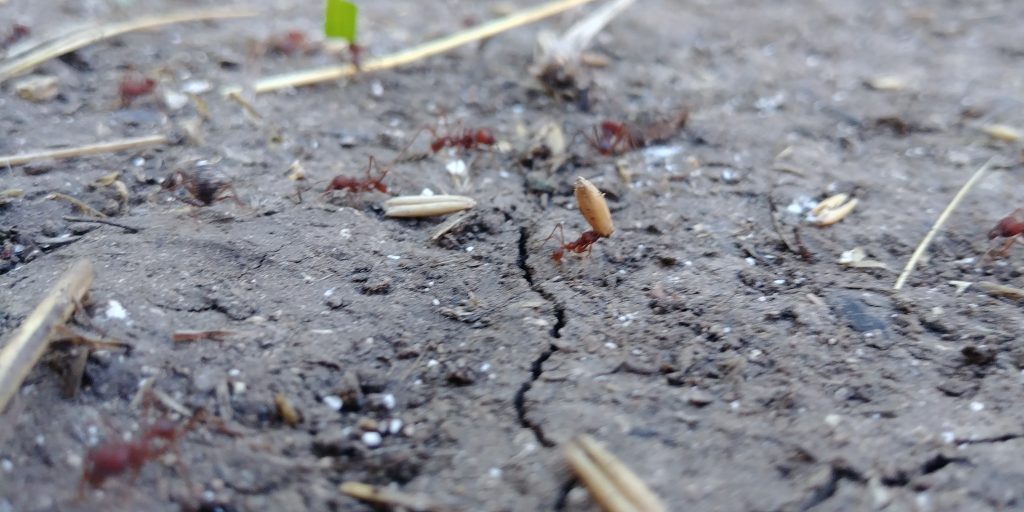 Although in large part due to habitat loss, reduction in the population of the red harvester ant, Pogonomyrmex barbatus has also contributed to the decline of the lizards. Red harvester ants make up 65% of the lizards’ diet and are also at risk of habitat loss. Red harvesters are relatively large, mound-building ants with a square head that forages for grass seeds during the day. The average colony size is around 10,000 with only one queen that can live up to 20 years. Unlike other ants, once the queen dies, the mound dies. During her long life, she produces 10,000 workers a year to collect seeds and feed the colony – all of which only live one year. Most of the ants are sterile female workers, but there are also reproducing females, or alates that mate and then leave to form new colonies. Less than 1% of mated females survive due to predation while searching for new areas to start a mound. Although the workers travel up to 130 feet from the mound to forage for grass seeds, many new areas are not suitable because of lack of food supply. A colony that persists for two years has a 95% chance of survival. Therein lies the role of the land steward.
Although in large part due to habitat loss, reduction in the population of the red harvester ant, Pogonomyrmex barbatus has also contributed to the decline of the lizards. Red harvester ants make up 65% of the lizards’ diet and are also at risk of habitat loss. Red harvesters are relatively large, mound-building ants with a square head that forages for grass seeds during the day. The average colony size is around 10,000 with only one queen that can live up to 20 years. Unlike other ants, once the queen dies, the mound dies. During her long life, she produces 10,000 workers a year to collect seeds and feed the colony – all of which only live one year. Most of the ants are sterile female workers, but there are also reproducing females, or alates that mate and then leave to form new colonies. Less than 1% of mated females survive due to predation while searching for new areas to start a mound. Although the workers travel up to 130 feet from the mound to forage for grass seeds, many new areas are not suitable because of lack of food supply. A colony that persists for two years has a 95% chance of survival. Therein lies the role of the land steward.
Along with habitat loss, harvesters are also predated upon by other herpetofauna, exposed to pesticides, and competitively excluded by invasive red fire ants. Studies show natural predators including doves, mockingbirds, and cardinals as well as robber flies, wasps, assassin bugs and dragonflies, are not causing a significant decline in the ant populations.
Invasive red fire ants do not directly kill harvesters but instead forage in the same areas “competitively excluding” them by starving them to death. Another man-made issue negatively influencing the ants is non-target ant treatments or broadcast treatments. These are often the easier and more efficient method to treat large areas but at the cost of treating anything that will take the bait. As the nature of the beast(s), invasive species often times invade areas with little to no natural predators and often times utilize the resources available or reproduce faster than similar native species.
As stewards of the land, it is our responsibility to not only manage against invasive species but to provide for the native ones. The most influential means to provide for native species is to enhance native habitats and maintain them. Instead of managing for a species, manage the habitat to benefit multiple species and likely increase biodiversity in an area.
In open, relatively flat grasslands and prairies where both harvester ants and Texas horned lizards thrive, fires historically kept woody plants from encroaching on the area, removing some of these encroaching species while simultaneously reseeding within the optimal foraging area can aid in restoring these areas back to native grasslands. Another management technique recommended is spot treating fire ants with a bait designated for the species that allows fewer non-targets to be impacted and ensures each fire ant mound is discovered and treated. This is also a more cost-effective treatment as far as the cost of bait since none is wasted. Often, fire ants are found within the same area as the harvesters making selective treatments difficult.
It is extremely difficult to translocate a harvester ant mound without a tree spade but there are ways to treat the fire ants selectively. In an attempt to reduce the number of non-target species harmed, treat the fire ants later in the evening since harvesters do not forage at night like fire ants. In addition, using Spinosad (Justice and Eliminator) in a bait station with holes drilled at 1/16th of an inch will allow fire ants in but no other species (there are designs for bait stations with old coffee cans).
More warm days are just ahead of us and fire ants will become more active during this time. Like most invasive species, we will not likely ever eradicate the fire ants completely but it is crucial to treat throughout the year in order to knock the populations back. Since many ground-nesting species begin to mate in the spring, (lizards in late April and lay eggs a couple of weeks later, quail lay eggs around April to June, Killdeer early March, Texas Tortoise June to September, freshwater turtles emerge in warm spring), it is especially important to treat now into the early summer. Plateau uses Extinguish Plus as a treatment, which is similar to Amdro. These relatively inexpensive baits are safe to use in pastures that are being grazed and can last up to 12 months depending on reinvasion pressure. Other baits are available and a good resource for information on them can be found at fireant.tamu.edu.
Conservation will forever be a search for the balance between wildlife management and the needs of people, but remember that if we want Texas natives like the horned lizard to persist and thrive, we must stay active as good land stewards and continue to manage the land in the most efficient and effective manners we know.
Back to TopBack to TopSpring Wildlife Management Activity Checklist
By Kameron Bain, Landowner Account Manager
This winter’s weather has been a roller-coaster but that has not stopped spring from arriving. From bluebonnets blooming to birds zipping around, the signs of spring are popping up all around us. This is an important season for wildlife management plan landowners with several key activities to accomplish over the next three months.
- Nest Boxes & Supplemental Shelter: Spring birds are starting to arrive, clean out your nest boxes ASAP
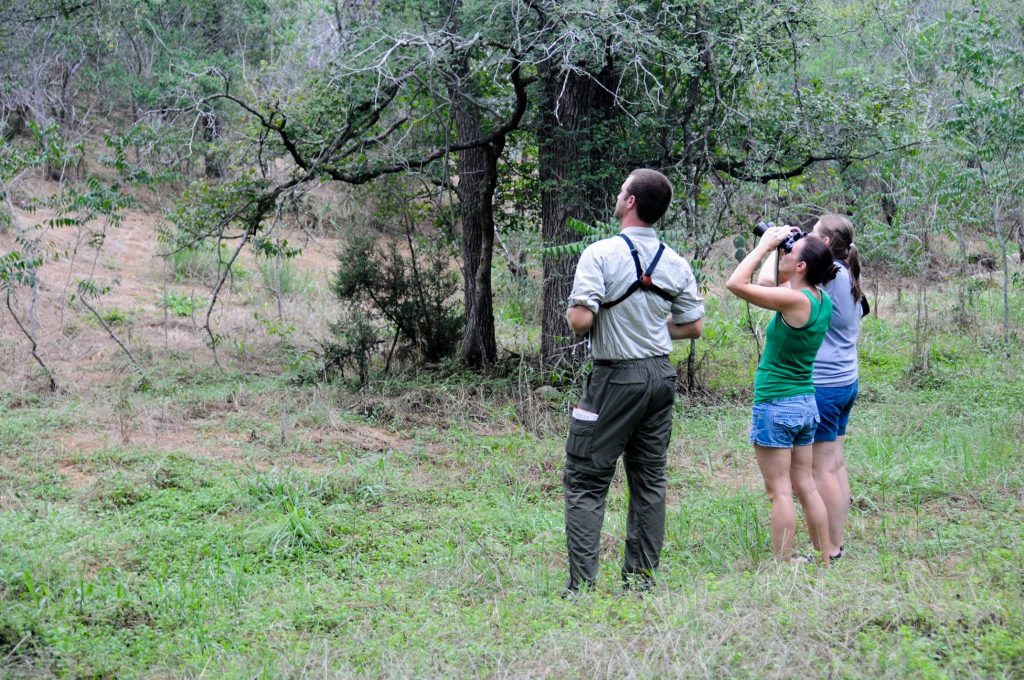 Predator Control
Predator Control
- Imported Red Fire Ant Control
- Brown-headed cowbirds during breeding bird season
- Erosion Control
- Supplemental Water
- Spring Breeding Bird Surveys
- Re-Seeding Native Grasses
Texas Treasures
By Lanette Patterson, Administrative Assistant
In early March, as Texas birders break out their binoculars to witness the return of many migratory birds from their wintering roosts in more southerly climes, a different sort of migration is taking place: Texas families and college students flocking to the third coast for fun in the sun, wind, and waves. From Texas Point National Wildlife Refuge to South Padre Island, and all points in between, the lure of the Texas coast is strong.
Central Texans have long nurtured a deep love affair with Port Aransas, in particular. Perhaps it’s the proximity. Perhaps the small town feel reminds Austinites of quieter times and a slower pace. Perhaps we are simply motivated by fond childhood memories of time spent with our beach-loving elders.
My own love affair with Port A began on a family trip the summer I was 8 years old. One late afternoon, after a full day of sand, surf, and sunburn, my mother and aunt strolled the beach. With my cousin and me (annoyingly) scampering not far behind, they came upon a large group of sand dollars revealed by the receding tide.
The eagerness with which they gathered and their insistence that we keep our prancing feet at a distance, lest we crush these delicate gems, drove home the lesson: a sand dollar was a novelty; and a group of them was, without a doubt, a rare and precious find. My memory of this event has fueled a lifelong obsession with beachcombing.
Fast-forward a couple of decades or so. My 6-year old daughter and I set out for what has become many mother-daughter pilgrimages to the Texas coast. This was a special trip: we were embarking on our first sand dollar hunt together. Knowing our chances of finding a whole sand dollar on the public beaches of Port Aransas would be next to impossible, I set a course a bit further northeast. Acting on a tip, I hired a fishing guide to ferry us across a bay to a secret spot on Matagorda Island.
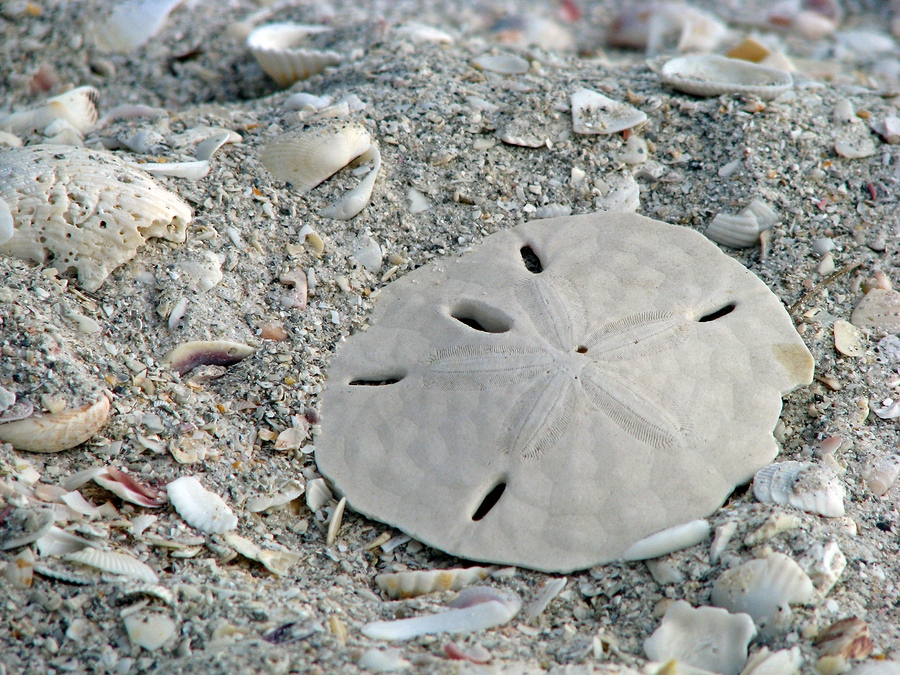 Well-supplied with bottled water and sunscreen, we set up camp and began our quest. Beachcombing takes patience, and it was a slow start. Before long, however, her sweet voice rang out behind me, “Mommy! I found a sand dollar!” She had found her first. I threw my hands into the air, setting my thus-far meager finds to launch, with a delighted, “WAAHOOOOO!”
Well-supplied with bottled water and sunscreen, we set up camp and began our quest. Beachcombing takes patience, and it was a slow start. Before long, however, her sweet voice rang out behind me, “Mommy! I found a sand dollar!” She had found her first. I threw my hands into the air, setting my thus-far meager finds to launch, with a delighted, “WAAHOOOOO!”
Do you know what you call a group of sand dollars? Why a “purse” of course. Or a “fortune.” We went home with a very fat purse, indeed, that afternoon… and have amassed a fortune many beach vacations since.
My family’s scavenging has evolved over the years. Our broader shell collection boasts diverse sizes and colors of cockles, scallops, and lightning whelks (the cherished State shell of Texas), among others, all in varying degrees of wholeness. I’ve found that the clipped tops of less than perfect lightning whelks mount handsomely within a mosaic mural.
A single spirulla I picked up along the Padre Island National Seashore adorns my dashboard, snuggled next to a tiny wooden carving of a mermaid. We’ve also branched into sea beans—poking around for shinies and corkies within the wrack. Our sea glass collection is comprised exclusively of empty whiskey flasks, their rusted screw tops fused in place.
Mustang Island State Park offered up one of our most astonishing finds. Stepping barefoot out of the car one blustery June afternoon, I turned to the water and walked straight to a full string of lightning whelk egg casings tangled within the sargassum that blanketed the beach. The string, dislodged from the gulf floor by tumultuous waves, stretched the length of my arm, and each quarter-size casing still held tiny live whelks within. My husband and I walked it to a nearby jetty to deposit it among the protective safety of the granite blocks, with the hopes that the hatching would continue undisturbed.
We are in the thick of busy season here at Plateau. It is “all hands on deck” until the end of April, as our dedicated team of professionals applies its collective energies to helping Texas landowners plan their move into wildlife management valuation. As the season ends, however, with another school year wrapping up shortly thereafter, the call of the Texas coast will grow to impossibly irresistible levels. Like me, I hope you will find time to take a break from the wildlife and head for the salt life.
In closing, I’m happy to share a few personal beachcombing lessons I’ve picked up along the way. May your purse grow fat.
- Pick a good beach. The more secluded the better. Oh, did you think I would share my secret spot? Unlikely! I will share a reliable runner-up, however: Take the Jetty Boat from Fisherman’s Wharf in Port A to St. Jo Island. I’ve collected the teeniest sand dollars ever where the beach meets the jetty, and plenty of big ones moving further down the island. Enjoy some birding and fishing while you’re there. fishermanswharfporta.com/san-jose-island
- Equip yourself. A good sturdy stick is a must for picking through flotsam. A mesh bag or small bucket will hold your Coke, as well as your treasure.
- Beachcomb at low tide. Or at high tide. Before a storm. Or after a storm. And anytime in between.
- Take your time. If you are seeking, you must not stop until you find. Your treasure will be your reward.
- Train your eye to look for round things. A sand dollar hides beneath the sand, but its center star crests and peeks above the surface. What your peripheral vision may mistake for blobs of sea foam or gull poo may actually be that which you seek. When in doubt, here’s where your stick comes in handy.
- Double back. That 20-foot stretch of sand you just devoted 10 minutes of your life to without avail? A change of perspective can yield surprising results.
- Take notice of other treasures. Sand dollars may be your ultimate goal. Yet, all of nature yearns to be admired. If a bit of pink coral or broken shard of iridescent abalone catches your eye, by all means, admire it. Mother Nature is watching. She rewards those who pay attention.
- It’s not always a rock. Sometimes it’s a lightning whelk. Sometimes it’s a giant eastern murex. Take the time to dig or fish it up.
- Let the bird show the way. I don’t know why. Sometimes it just works.
- Take a break. After an hour or more with my head lowered and eyes trained to the sand at my feet, I raised my gaze one bright morning to behold a pod of dolphins passing through. If you forget to look up every now and then, you just might miss something good.
10 Signs You’re a Wildlife Services Technician
By Damon Speidel, Wildlife Services Technician III
- On the weekend, you can’t pick up anything over 25lbs without directly comparing it to the weight of a 50lb feed bag
- You can’t ratchet anything down on the bed of the truck or trailer without saying “that’s not going anywhere”
- You use work terms such as IRFA, BRUM, and CHEM in the presence of your significant other
- Your significant other actually knows what those terms mean
- You’ve bragged about the highest number of nest boxes you’ve checked in a single day
- Your voice has hit an octave you didn’t know you had after opening a nestbox you found to be full of wasps
- You get back to the office and literally can’t remember where you were that day
- You know the location of every HEB within a 200-mile radius
- You shed a small tear when you check your work email in the field only to find one that says there are donuts, cake, or cookies in the break room
- You’ve looked at a nest box you just installed and said out loud, “I’d live in that”
Service Spotlight: Wildlife Management Plan Refile
As most of you know, April 30th is the deadline to submit and file your application to manage for wildlife rather than traditional ag. However, many who are currently in wildlife management valuation are not aware this deadline may just be as important for them. This is because April 30th is also the deadline to re-file your wildlife management plan.
You may need to re-file your plan if any of these changes happened in 2018:
- Change in legal ownership name
- Change in acreage size
- Wildlife management plan is older than five years
- Received a request letter from your Appraisal District
Addressing potential compliance issues now takes much less effort at a much lower cost than is the case if the county appraiser takes issue with your expiring plan or not addressing changes to the property. Plateau offers options to re-file your wildlife management plan with ease and at a lesser cost than your original plan. Please contact us today if you would like a quote.
Back to TopBack to Top
Bee Innovative: A recap from the American Beekeeping Federation Conference
By Jan Gunter, Realtor®, Texas Land Specialist at Plateau Land Group, LP
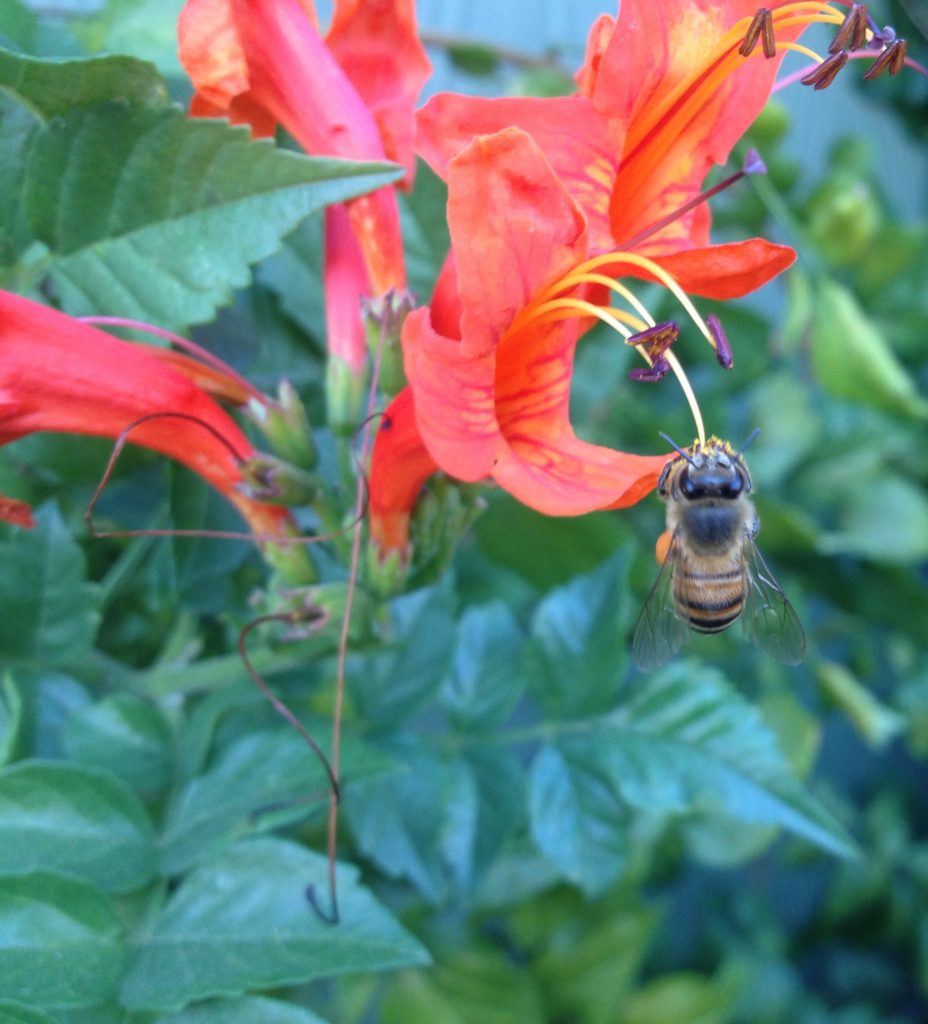 The American Beekeeping Federation (ABF) Conference & Tradeshow, Bee Innovative, was held in January in Myrtle Beach, South Carolina. Conference attendees included commercial beekeepers, small-scale beekeepers, researchers, educators, and exhibitors. As an ABF member, and having worked in my family’s bee business growing up, I attended this year’s conference and am sharing this update from the beekeeping industry with you. This is by no means an exhaustive list, but it gives at least a partial view of some of the conference workshops and topics.
The American Beekeeping Federation (ABF) Conference & Tradeshow, Bee Innovative, was held in January in Myrtle Beach, South Carolina. Conference attendees included commercial beekeepers, small-scale beekeepers, researchers, educators, and exhibitors. As an ABF member, and having worked in my family’s bee business growing up, I attended this year’s conference and am sharing this update from the beekeeping industry with you. This is by no means an exhaustive list, but it gives at least a partial view of some of the conference workshops and topics.
Many of the sessions at the conference related to threats to the bees including the Varroa mite which has wreaked havoc on the bees since the 1980s. Research is being done by universities on this critical topic.
Honey Bee Health Coalition, HoneyBeeHealthCoalition.org, is working collaboratively across the country to implement science solutions to achieve a healthy population of honey bees, native and managed pollinators. Their approach includes hive management (pest and disease), forage and nutrition, and crop pest control and management.
The Pollinator Stewardship Council, PollinatorStewardship.org, works to protect honey bees and native pollinators from the adverse impact of pesticides. The council created a short film documentary, “Keep the Hives Alive Tour” – a partnership of 30+ nonprofit groups focused on sustainable agriculture. They are calling for a moratorium on the use and registration of the neonic class of pesticides for the protection of pollinators, the food web, and the biodiversity of the ecosystem.
Bee Storage Is Not Just for Winter: Commercial Scale Brood Break for Varroa Control – Dr. Brandon Hopkins, Washington State University, Pullman, WA
Dr. Hopkins recommends 40-45 degree cold storage for bees for a few weeks to control Varroa mites. Successful trials have been completed using this method for varroa mite control.
The Bee Informed Partnership, from the University of Maryland, BeeInformed.org, is a collaboration of efforts across the country from some of the leading research labs and universities in agriculture and science to better understand honey bee declines in the United States. Supported initially by the United States Department of Agriculture and the National Institute of Food and Agriculture but now a not-for-profit, Bee Informed is working with beekeepers to better understand how together we can keep healthier bees.
Buzzing Across America, BuzzingAcrossAmerica.com, is the American Honey Queen educational site, including lessons for teachers, bee & honey facts, “from the sweetest spokespeople in America.” The American Honey Queen and Princess travel the United States for a year as spokespeople for the honey and beekeeping industry and help educate children and adults.
Mite Check Mobile App is a new app for beekeepers with information on how to check your colonies for mites.
Keynote Presentation: Mites Matter! – Dennis van Engelsdorp, Department of Entomology, University of Maryland, College Park, MD & President, Bee Informed Partnership.
Van Engelsdorp emphasized the importance of more hive checks through the Bee Informed Partnership.
The Art & Science of Getting Great Honey Bee Forage on the Landscape – Peter Berthelsen, The Bee & Butterfly Habitat Fund, St. Paul, NE
Berthelsen spoke about beekeeping sustainability and the importance of good bee forage. Need for high-quality pollinator habitat and noted that introduced plant species – specifically clover species – are necessary for healthy bees. (This writer would note that clover also makes a wonderful, light honey flavor – one of my favorites!)
The National Honey Board, Honey.com, promotes responsible industry practices to ensure the honey consumed every day is trustworthy and pure. The NHB provided an update on the accomplishments of the last year, during which they participated in the EPCOT International Flower and Garden Festival, partnered with Celestial Seasonings and Thomas English Muffins to promote honey, and encouraged people to use honey in new and innovative ways, including in coffee, baked goods, whiskey, and beer.
The Kids and Bees Program invited hundreds of local children and teachers to hands-on-exhibits such as the art of beekeeping, the science of beekeeping, and the future of bees. The children learned about beeswax, honey, pollination, ultraviolet bee vision and much more, engaging with beekeepers and Honey Queens through the interactive activities.
Country Creek Honey, Beck and Steve Tipton, of Meriden, Kansas, held a workshop on skin care with beeswax and honey. Becky demonstrated how to make lotions, cleaners, soaps, lip balm, and many other products with beeswax and honey.
Ginger Reuter of Amery, Wisconsin, demonstrated candle making with beeswax. Kristi Sanderson, of Sweet Prairie Honey in Olathe, Kansas, demonstrated how to make creamed honey. George Hansen, of Foothills Honey in Colton, Oregon, gave a workshop in encaustic painting or painting with beeswax.
As you may be aware, many commercial beekeepers move their bees to the almond groves in California, so more than half of the commercial hives in the US go to the almond fields during almond pollination (late winter and early spring). The almond growers depend on it, and with the declines in bee populations and the increasing challenges of maintaining healthy colonies, many beekeepers increasingly depend on the income from almond pollination.
Jan Gunter’s beekeeping pedigree: Beekeeping runs deep in my blood. I come from a family of beekeepers, namely Walker Honey Company (now Walker Honey Farm) in Rogers, Texas, which was founded in 1932 by my grandfather and father, and which is carried on now by my brother and his family. I grew up working in the family business, working bees, extracting and packing honey.
During my college years, I was the Texas Honey Queen and American Honey Princess, serving as a promoter of the honey industry for two years. My family has been members of the American Beekeeping Federation for 65 years, since 1954. My dad and brother, GC Walker, Jr., and Clint Walker, III, have both served as president of the ABF, and my nephew, Jonathan Walker, currently serves on the ABF Board of Directors. Clint and Jonathan Walker, and Walker Honey Farm are featured in the first episode of the 2018 Netflix Documentary, Rotten, Lawyers, Guns & Honey.
Back to TopBack to Top
The People of Plateau
Name: Damon Speidel
Title: Wildlife Services Technician III
Time with Plateau: 7 Years
Hometown: Austin, Texas
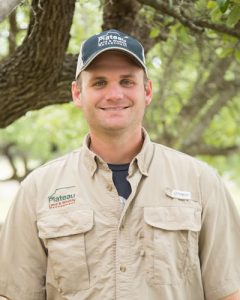
Before working at Plateau, what was the most unusual or interesting job you’ve ever had? Various movie crew positions
What was your first job? Central Market Cafe cashier in Austin
What do you like most about working at Plateau? Visiting all the private land in Texas that most won’t get to experience
How do you define success? Doing what you love, being good at it, and getting recognized for it.
If given a chance, who would you like to be for a day? I can’t think of anyone I’d like to be, even for a day, other than myself
What is your favorite food? A nice MLT. Mutton, lettuce and tomato sandwich, when the mutton is nice and lean, and the tomato is ripe.
If you were an animal what would you be? Killer whale
People would be surprised if they knew…? I haven’t opened a fortune cookie since July of 2007.
Where would you like to travel to? I would love to stand on the moon’s surface and look back at the Earth.
If you could learn to do anything, what would it be? How to be an expert at the piano
You’re happiest when? Fishing, while in a nostalgic mood and pondering life
Back to TopBack to TopPlateau Land Group Featured Listing
Little River Ranch
Holland, Bell County, TX
106 acres | $1,199,999
Little River Ranch is a rare and unique live water property waiting to be your next family oasis. This revenue generating property has been in the same family for 100+ years. Nestled on the Little River between I-35 and Hwy 95, this location is just minutes away from Temple and Belton. Long range views, majestic live oaks, 140 feet of elevation change, 1,300 feet of river frontage, and 3,000 feet of paved road frontage combine to make this a one-of-a-kind property.
View all of Plateau Land Group’s listings.
Click here to receive PLG’s newest listings by email.
Back to TopBack to Top





Sorry, the comment form is closed at this time.